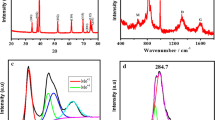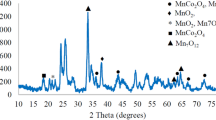Abstract
Our energy sources such as fossil fuels and coal are limited and cause air pollution. Hydrogen has been promoted as an alternative source of energy, which is renewable, cost-effective, and nature-friendly. Hydrogen evolution reaction (HER) can be used for the mass production of hydrogen at a very low cost. An active and efficient electrocatalyst is required to perform this reaction. To date, platinum (Pt) shows the highest efficiency; however, its high cost and low abundance hinder its large-scale uses. Molybdenum carbide has a similar electronic structure as that of platinum (Pt); hence, it shows high electrocatalytic activity towards HER. In this study, Mo2C/MoC/C composite has been synthesized using magnesium as a reducing agent. Carbon provides a highly conducting environment to Mo2C and MoC nanoparticles, and hence, the electrochemical performance is enhanced. The prepared sample shows a small Tafel slope of 125.5 mV/dec and long-term stability up to 5000 cyclic voltammetry cycles.



Similar content being viewed by others
References
Huang Y, Miao YE, Fu J et al (2015) Perpendicularly oriented few-layer MoSe2 on SnO2 nanotubes for efficient hydrogen evolution reaction. J Mater Chem A 3:16263–16271. https://doi.org/10.1039/c5ta03704b
Li W, Liu D, Yang N et al (2019) Molybdenum diselenide – black phosphorus heterostructures for electrocatalytic hydrogen evolution. Appl Surf Sci 467–468:328–334. https://doi.org/10.1016/j.apsusc.2018.10.127
Yang L, Yu J, Wei Z et al (2017) Co-N-doped MoO2 nanowires as efficient electrocatalysts for the oxygen reduction reaction and hydrogen evolution reaction. Nano Energy 41:772–779. https://doi.org/10.1016/j.nanoen.2017.03.032
Hua W, Sun H-H, Xu F, Wang J-G (2020) A review and perspective on molybdenum-based electrocatalysts for hydrogen evolution reaction. Rare Met 394(39):335–351. https://doi.org/10.1007/S12598-020-01384-7
Xia L, Zhang X, Song H et al (2020) Structural engineering of hierarchically hetestructured Mo2C/Co conformally embedded in carbon for efficient water splitting. Int J Hydrogen Energy 45:22629–22637. https://doi.org/10.1016/J.IJHYDENE.2020.06.049
Wang Y-Z, Ding Y-M, Zhang C-H et al (2021) Formation of hierarchical Co-decorated Mo2C hollow spheres for enhanced hydrogen evolution. Rare Met 4010(40):2785–2792. https://doi.org/10.1007/S12598-021-01765-6
Pi C, Zhao Z, Zhang X et al (2021) In situ construction of γ-MoC/VN heterostructured electrocatalysts with strong electron coupling for highly efficient hydrogen evolution reaction. Chem Eng J 416:129130. https://doi.org/10.1016/J.CEJ.2021.129130
Zhou F, Zhou Y, Liu G-G et al (2021) Recent advances in nanostructured electrocatalysts for hydrogen evolution reaction. Rare Met 4012(40):3375–3405. https://doi.org/10.1007/S12598-021-01735-Y
Upadhyay S, Pandey OP (2020) One-pot synthesis of pure phase molybdenum carbide (Mo2C and MoC) nanoparticles for hydrogen evolution reaction. Int J Hydrogen Energy 45:27114–27128. https://doi.org/10.1016/j.ijhydene.2020.07.069
Xiao P, Yan Y, Ge X et al (2014) Investigation of molybdenum carbide nano-rod as an efficient and durable electrocatalyst for hydrogen evolution in acidic and alkaline media. Appl Catal B Environ 154–155:232–237. https://doi.org/10.1016/j.apcatb.2014.02.020
Ren JT, Song YJ, Yuan ZY (2018) Facile synthesis of molybdenum carbide nanoparticles in situ decorated on nitrogen-doped porous carbons for hydrogen evolution reaction. J Energy Chem. https://doi.org/10.1016/j.jechem.2018.07.006
Das D, Santra S, Nanda KK (2018) In situ fabrication of a nickel/molybdenum carbide-anchored N-doped graphene/CNT hybrid: an efficient (pre)catalyst for OER and HER. ACS Appl Mater Interfaces 10:35025–35038. https://doi.org/10.1021/acsami.8b09941
Chaitoglou S, Giannakopoulou T, Speliotis T, Vavouliotis A, Trapalis C, Dimoulas A (2018) Mo2C/graphene heterostructures: low temperature chemical vapor deposition on liquid bimetallic Sn-Cu and hydrogen evolution reaction electrocatalytic properties. Nanotechnology 30:125401. https://doi.org/10.1088/1361-6528/aaf9e8
Mir RA, Pandey OP (2020) An ecofriendly route to synthesize C-Mo2C and C/N-Mo2C utilizing waste polyethene for efficient hydrogen evolution reaction (HER) activity and high performance capacitors. Sustain Energy Fuels 4:655–669. https://doi.org/10.1039/c9se00516a
Pant B, Ojha GP, Acharya J, Park M (2021) Eggshell membrane templated synthesis of Ni/MoC decorated carbon fibers with good electrochemical behavior. Int J Hydrogen Energy 46:2774–2782. https://doi.org/10.1016/j.ijhydene.2020.10.139
He T, He Y, Li H et al (2021) Mo2C nanospheres anchored on nickel foam as self-supported electrode for high-performance hydrogen production. J Solid State Chem 294:121825. https://doi.org/10.1016/j.jssc.2020.121825
Wang Q, Mi F, Li J et al (2021) Tungsten doping generated Mo2C-MoC heterostructure to improve HER performance in alkaline solution. Electrochim Acta 370:137796. https://doi.org/10.1016/j.electacta.2021.137796
Aydinyan SV, Gumruyan Z, Manukyan KV, Kharatyan SL (2010) Self-sustaining reduction of MoO3 by the Mg-C mixture. Mater Sci Eng B Solid-State Mater Adv Technol 172:267–271. https://doi.org/10.1016/j.mseb.2010.05.028
Upadhyay S, Pandey OP (2020) Synthesis of layered 2H–MoSe2 nanosheets for the high-performance supercapacitor electrode material. J Alloys Compd 157522. https://doi.org/10.1016/j.jallcom.2020.157522
Mir RA, Pandey OP (2018) Influence of graphitic/amorphous coated carbon on HER activity of low temperature synthesized Β-Mo2C@C nanocomposites. Chem Eng J 348:1037–1048. https://doi.org/10.1016/j.cej.2018.05.041
Li J, Zhou C, Mu J et al (2018) In situ synthesis of molybdenum carbide/N-doped carbon hybrids as an efficient hydrogen-evolution electrocatalyst. RSC Adv 8:17202–17208. https://doi.org/10.1039/c8ra02020e
Kang Q, Li M, Wang Z et al (2020) Agaric-derived N-doped carbon nanorod arrays@nanosheet networks coupled with molybdenum carbide nanoparticles as highly efficient pH-universal hydrogen evolution electrocatalysts. Nanoscale 12:5159–5169. https://doi.org/10.1039/C9NR10236A
Chaitoglou S, Giannakopoulou T, Tsoutsou D et al (2019) Direct versus reverse vertical two-dimensional Mo2C/graphene heterostructures for enhanced hydrogen evolution reaction electrocatalysis. Nanotechnology 30:415404. https://doi.org/10.1088/1361-6528/AB3155
Chen X, Qi J, Wang P et al (2018) Polyvinyl alcohol protected Mo2C/Mo2N multicomponent electrocatalysts with controlled morphology for hydrogen evolution reaction in acid and alkaline medium. Electrochim Acta 273:239–247. https://doi.org/10.1016/j.electacta.2018.04.033
Lv C, Wang J, Huang Q et al (2016) Facile synthesis of hollow carbon microspheres embedded with molybdenum carbide nanoparticles as an efficient electrocatalyst for hydrogen generation. RSC Adv 6:75870–75874. https://doi.org/10.1039/c6ra16490k
Tang Y, Li W, Jiao L et al (2017) Mo2C-Ni-modified nitrogen-doped carbon nanofiber toward efficient hydrogen evolution reaction. New J Chem 41:12956–12961. https://doi.org/10.1039/c7nj02611k
Cao Q, Zhao L, Wang A et al (2019) Tailored synthesis of Zn-N co-doped porous MoC nanosheets towards efficient hydrogen evolution. Nanoscale 11:1700–1709. https://doi.org/10.1039/c8nr07463a
Sun Y, Wang B, Yang N et al (2019) Synthesis of RGO-supported molybdenum carbide (Mo2C-RGO) for hydrogen evolution reaction under the function of poly(ionic liquid). Ind Eng Chem Res 58:8996–9005. https://doi.org/10.1021/ACS.IECR.9B00209
Šljukić B, Vujković M, Amaral L et al (2015) Carbon-supported Mo2C electrocatalysts for hydrogen evolution reaction. J Mater Chem A 3:15505–15512. https://doi.org/10.1039/c5ta02346g
Acknowledgements
The authors are highly thankful to SAI lab, Thapar Institute of Engineering and Technology, Patiala, for XRD analysis. The authors are grateful to Dr. R. Venkatesh (Scientist-E) for FESEM measurements. The authors offer special gratitude to Mr. Manu Vashistha, AIRF-JNU, New Delhi, for TEM analysis.
Funding
This work was supported by UGC-DAE Consortium for Scientific Research (project no.- CSR-IC-239/2017–18/1320) Indore, India.
Author information
Authors and Affiliations
Corresponding author
Ethics declarations
Conflict of interest
The authors declare no competing interests.
Additional information
Publisher's Note
Springer Nature remains neutral with regard to jurisdictional claims in published maps and institutional affiliations.
Highlights
•Mo2C/MoC/C nanocomposite: an efficient electrocatalyst for HER
•Carbon provides a high conductivity environment and guards active sites of the electrocatalyst
•Cost-effective method to prepare Mo2C/MoC/C in one step
•Mo2C/MoC/C has good HER activity in an acidic medium
Supplementary information
Below is the link to the electronic supplementary material.
Rights and permissions
About this article
Cite this article
Upadhyay, S., Pandey, O.P. Synthesis of Mo2C/MoC/C nanocomposite for hydrogen evolution reaction. J Solid State Electrochem 26, 559–564 (2022). https://doi.org/10.1007/s10008-021-05096-5
Received:
Revised:
Accepted:
Published:
Issue Date:
DOI: https://doi.org/10.1007/s10008-021-05096-5




